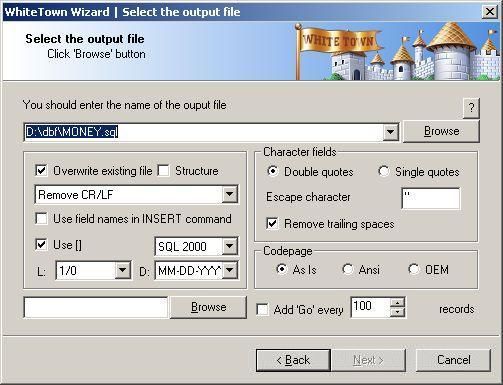Convert Dbf To Sql
| DBF to SQL Converter allows you to convert your dbf files to SQL script. You can apply this script on any SQL server, so you can easily transfer your data to a new system. There are several different SQL servers, but this program allows you to customize the output file. Currently it supports MS SQL, MySql, PostgreSQL, SQLite, etc. You can also select various options, like type of quotes (single or double), using square brackets around field names, an action with carrier return and line feed symbols. There are a lot of parameters that allow you to customize the output file.The program supports dBase III, dBase IV, FoxPro, VFP and dBase Level 7 formats. The first tab allows you to select source files. You can select for conversion one or several files. If your files contain non-latin characters then you have to choose a correct charset. Command line parameter: Usually DBF files use single-byte encoding. The second tab allows you to select the output folder or file.
If you selected a file then a content of all source files will be converted to this file. Command line parameters are:
Besides, you can define the program's behaviour what is necessary to do when an output file already exists. Command line parameters are:
Encoding of the output file The last tab allows you to customize the output file.
Besides there are some special command line parameters:
If the converter does not have enough parameters or some error occurs then the batch process will be interrupted and the converter displays main window to resolve the problem. After successful conversion you will see a list of output files. | Online Help
|

Convert Mysql Script To Mssql
Just launch DBF to SQL Converter, select source file (s), the output file/folder, select necessary parameters, such as a field delimiter, code page, quotes etc. Then click the button 'Expert mode' and you will see how all your settings become command line parameters! In the.dbf file folder, I have.fpt files also which are for 'memo' datatype I suppose. Another solution I tried is as below: I installed MS Visual Foxpro Driver and used the same for importing DBF files into SQL server 2008 but then I am able to 'Edit Mappings' and also can 'Preview' the data.
Convert Foxpro Dbf To Sql Server
- Our DBConvert/DBSync for FoxPro and MSSQL provides a powerful and comfortable way to convert and sync data from MS Visual FoxPro databases (.dbc) and MS Visual FoxPro free tables (.dbf) to Microsoft SQL Server, Windows Azure SQL databases.
- I want to convert several Table from foxpro (dbf, dbc) file to sql server. How can i do it? You can import dbf file to sql. You can follow instructions given Here.
